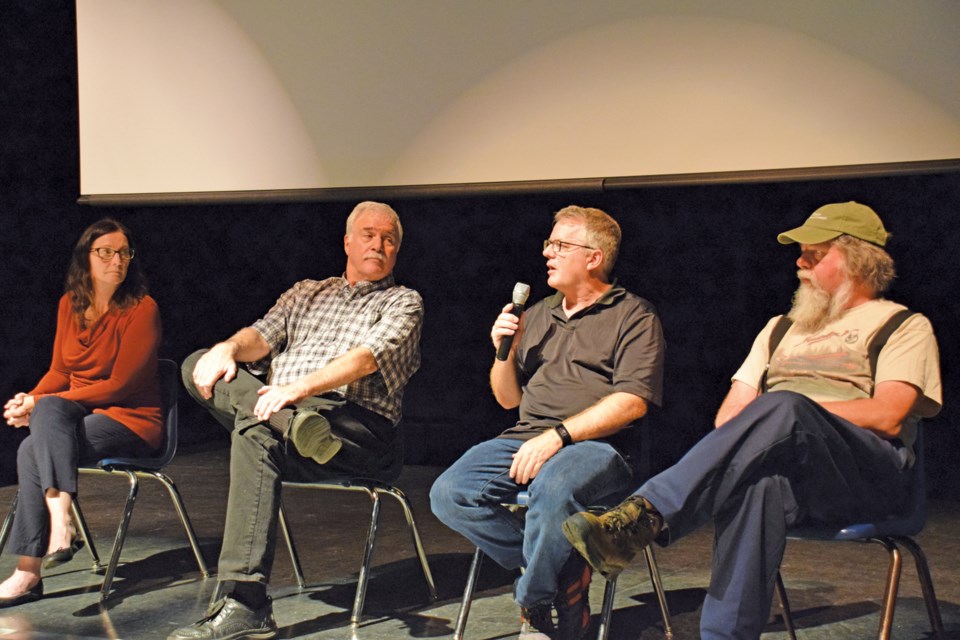B.C., and the Sunshine Coast, have been slow to respond to a “wake-up call” on wildfires that started sounding as far back as the 2003 Kelowna fires, according to a group of experts brought to the Coast by the Sunshine Coast Community Forest.
Forest ecosystem researcher Lori Daniels of UBC, wildfire preparedness consultant Bruce Blackwell, and foresters Brian McNaughton and Tom Bradley spoke at a public event June 10 at Chatelech Secondary after speaking to first responders and local government officials earlier in the day.
Daniels talked about what she called an “urgent need for transformative change” to cope with an “era of mega-fires that are large, intense and very difficult to control that are having a tremendous impact on our ecosystems and communities.”
She said one of the reasons fire behaviour has changed is a history of managing forests to retain timber value or visual characteristics.
She said dealing with the dangerous fuel accumulating in forests around at-risk communities is key to the change she’d like to see, but it isn’t always an easy sell to the public.
“Some people are very resistant. They don’t want to see trees cut near their neighbourhoods and they’re resistant to prescribed fire in the locations where it’s appropriate,” she said.
She also said at the moment the resources are limited.
Since 2004 the province has allocated about $250 million, but that only covered work on about 12,000 hectares out of the 1.6 million hectares she estimates need fuel cleanup.
It would cost about $3.5 billion, which she contrasted to the $19 billion spent on seismic upgrades over the same period.
“If we understood the risk and hazards of fire and we made it a priority, I think we could find the money.”
The need to change public attitudes and forest management practices was a common theme through the other presentations as well.
Blackwell said adding FireSmart principles to building codes, community planning, local bylaws and at home is vital.
“This is an effort that spans both private citizens and the government. If you’re not willing to FireSmart your house, what’s going on in Crown land isn’t going to amount to a hill of beans in most cases.”
Blackwell said B.C. is now in the third year of what he described as a regional drought which has left an accumulation of dead and dying fuel on forest floors. While the Sunshine Coast does not face the same risk of lightning-caused wildfires as other areas in the province, accumulated fuels in interface areas mean “one bad house fire on a July night when a northwester is blowing down the Strait and we could have a significant fire event.”
He closed by pointing out the work needed locally on a wildfire mitigation strategy.
“This region has no plan, has no initiative, is not actively working on protecting communities here from fire,” he said. “You urgently need to start something and you should take that message to your politicians.”
McNaughton, a retired district manager with the forests ministry, was brought in to talk about his experiences as an evacuee during the 2017 fires in the Williams Lake area, but he also weighed in on the need to manage dangerous fuel loads and reconsider forest management in general.
“If you think holding on to trees because they look nice is always the best – it’s not. There are going to be consequences and there are risks associated with that and you need to be evaluating it as you make those decisions.”
Bradley, forestry supervisor for the Slocan Integral Forestry Cooperative, a community forest in the Slocan Valley in southeastern B.C., talked about how they’re now conducting operations with the idea of making their tenure more fire resistant while still earning good revenue through logging.
Bradley said while community forests and the province can introduce new practices on the land they control, privately owned land is “the elephant in the room” when it comes to wildfire risks. “Currently there is no funding, no provision, no ability to carry out any form of treatment on that land.”
Later, during the question and answer session, Blackwell and Bradley said mitigating wildfire risks isn’t a short-term project.
“It took us 80 years to get into the mess we’re in at the moment [in the Slocan Valley],” said Bradley. “It’s going to take us not quite as long to get back out, but we’re thinking in terms of decades.”
The presentations were recorded and will be used for a series of “Wildfire at your Doorstep” events the Community Forest is holding over the next two weeks in partnership with Sunshine Coast ElderCollege.
The sessions will be:
Monday, June 17: 6.30 p.m. at Roberts Creek Hall
Wednesday, June 19: 6:30 p.m. at the Pender Harbour Legion
Monday, June 24: 6.30 p.m. at the Gibsons Public Market, 473 Gower Point Rd.
For more information visit www.sunshinecoasteldercollege.ca or www.sccf.ca



